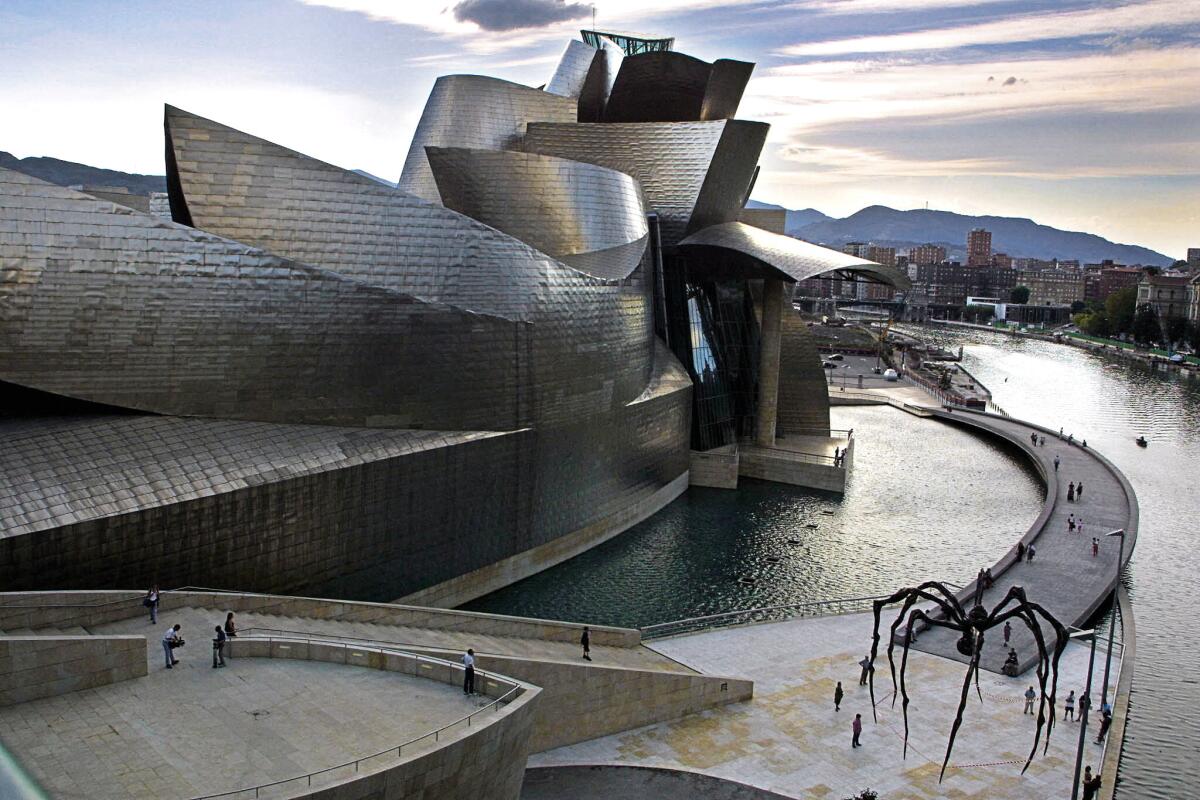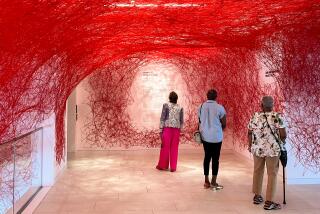The Guggenheim Bilbao reopens in COVID-hit Spain. For U.S. museums, a template?

The Guggenheim Bilbao reopened Monday — the first major cultural institution in Spain to do so since coronavirus closures in mid-March — and the very first stop for the 80 visitors who came that day? Temperature checks upon arrival.
With the coat check closed so as not to spread germs, mask-clad visitors carried their belongings on self-guided tours, using a Guggenheim app downloaded to their phones — just a few of the new safety measures in place at the art museum.
“It’s weird, in a way, we’re operating under these new circumstances,” said museum Director Juan Ignacio Vidarte. “But it’s a first step and we’re very excited about moving forward.”
The Frank Gehry-designed museum, in the Basque Country of northern Spain, is allowing a maximum of 400 visitors inside at any one time — 25% of its capacity — for timed visits. Guests are encouraged to reserve and pay for admission in advance online. Wearing masks indoors is mandatory. The flow of foot traffic has been revamped, charted as a single route through the museum — from the top floor, down — marked by graphic floor decals, like arrows, and wall signage.
Similar measures have been taken at the first U.S. museums that have reopened recently, including the Museum of Fine Arts, Houston on May 23 and the San Antonio Museum of Art on May 28.
Most U.S. museums, however, including the Metropolitan Museum of Art and Museum of Modern Art in New York, the Art Institute of Chicago and the biggest institutions in L.A. have yet to reopen. When they do, chances are, American Alliance of Museums President Laura Lott said, the museum-going experience will look similar throughout the U.S.
“The timing is different,” Lott said of museum reopenings, “but what [institutions] are doing in terms of reduced capacity and new safety measures that minimize or avoid person-to-person contact and enhanced sanitizing and cleaning protocols, that seems to be fairly consistent across museums opening now and in the coming weeks.”
At the Guggenheim Bilbao, a 15- to 20-person task force representing nearly every department at the museum began mulling reopening as soon as the museum closed March 14. The number of coronavirus cases in Spain is approaching 300,000, with more than 27,000 deaths. It’s among the countries in western Europe hardest hit by the virus, second behind Britain in case count and second behind Italy in deaths.
The museum worked with health authorities and local government officials on precautions, such as keeping visitors two meters (about 6½ feet) apart, more frequent and rigorous cleaning and disinfectant protocols and providing hand sanitizer to guests. It also conducted a “detailed analysis” of the museum’s unique needs, Vidarte said.
“We had to go through a 360 exercise,” Vidarte said, “involving curators, conservation, security, human resources, legal, visitors services, marketing, to understand all the variables that needed to be addressed.”
The museum swapped out display touchscreens and headphones for speakers that play soundtracks out loud, on a loop. It imposed additional social distancing restrictions on immersive, interactive works, such as Richard Serra’s “sculptural field” titled “The Matter of Time,” which viewers walk through and around, and artist Jenny Holzer’s granite benches, which visitors can no longer sit on.
The museum is showing a retrospective of Danish-Icelandic artist Olafur Eliasson. The exhibition features several immersive, experimental installations. One is a room filled with dense fog that changes colors. Typically about 30 or more people would cram together inside. Now? One individual, or one so-called “family unit,” at a time.
Which some visitors may see as an upside of the COVID 19-imposed circumstances, Vidarte said.
“It’s a unique opportunity to experience the museum with much less people and see works of art more intimately,” he said.
Public programs are on hold until at least the fall. To enforce social distancing, the museum’s cafe and restaurant are closed for now.
Privacy in the bathroom? Not a problem: Restrooms are restricted to one person at a time.
Some social distancing measures — such as timed visits and reduced visitor capacity, offset by extended operating hours — may outlive the crisis, Vidarte said, as they improve the visitor experience. And during the closure, he added, the museum strengthened its digital presence. “It was already a path we were going down, but it’s shown us that there are many ways we can use technology to enhance our mission and our mandate.”
The Guggenheim Bilbao typically receives about 1 million visitors a year, 70% of whom are tourists. This year it’s expecting 15% of its normal summer attendance — a loss of about 3 million euros, or about $3.4 million in revenue. Vidarte said he expects summer visitors “will be coming locally or from other areas in Spain or closer parts of Europe, like France.”
The museum is offering perks to locals. Members may invite a friend to attend for free. With the price of admission, non-members may become members for the summer. (Typically, membership is 40 euros, or about $45, for the year.)
“We’re trying to lure them to come back,” Vidarte said. “People are afraid to be in enclosed spaces, surrounded by people, and we want them to recover confidence.”
When the Museum of Fine Arts, Houston opened last week, nearly 500 visitors came the first day — about 7% of its capacity. Director Gary Tinterow said he expected pushback from guests complaining about having to wear masks, get their temperatures checked upon entry or practice social distancing, but the opposite turned out to be true.
“Everyone was respectful and mindful of our safety requirements and almost everyone expressed gratitude,” he said. “Some people cried in the galleries; some wrote notes about how grateful they were to return to a place that was so meaningful to them.”
That response may be a harbinger of things to come elsewhere, Tinterow added.
“Museum-goers, for the most part, are respectful individuals,” he said. “It’s not like a spring break party on the beach. There’s a particular code of behavior at museums and that happily facilitates proper health measures for COVID.”
No matter what safety measures individual museums take, reopening is “a poignant moment, a moment of recovery,” Vidarte said. “Museums provide spaces for inspiration and enjoyment and healing and we are happy to be providing that right now.”
More to Read
The biggest entertainment stories
Get our big stories about Hollywood, film, television, music, arts, culture and more right in your inbox as soon as they publish.
You may occasionally receive promotional content from the Los Angeles Times.











